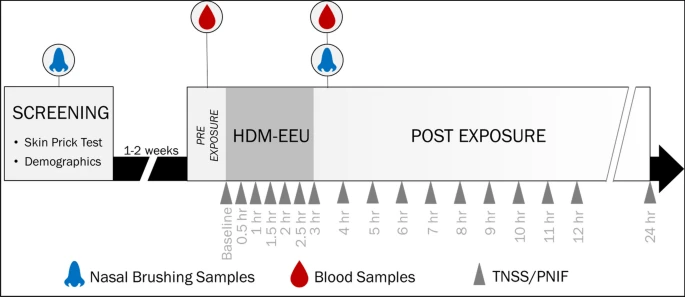- Research
- Open Access
Allergy, Asthma & Clinical Immunology 17, Article number: 34 (2021)
Rationale
The Environmental Exposure Unit (EEU), a controlled allergen exposure model of allergic rhinitis (AR), has traditionally utilized seasonal allergens. We sought to clinically validate the use of house dust mite (HDM), a perennial allergen, in the HDM-EEU, a specially designed facility within the larger EEU.
Forty-four HDM-allergic and eleven non-allergic participants were screened and deemed eligible for one of two 3-h exposure sessions in the HDM-EEU. Participants were exposed to a modest or higher HDM target, with blood and nasal brushing samples collected before and after allergen exposure. Symptomatic data, including Total Nasal Symptom Score (TNSS), Total Ocular Symptom Score (TOSS), Total Rhinoconjunctivitis Symptom Score (TRSS), and Peak Nasal Inspiratory Flow (PNIF) were collected at baseline, every 30 min until 3 h, on an hourly basis for up to 12 h, and at 24 h following the onset of HDM exposure.
The modest and higher HDM target sessions respectively featured cumulative total particle counts of 156,784 and 266,694 particles (2.5–25 µm), Der f 1 concentrations of 2.67 ng/m3 and 3.80 ng/m3, and Der p 1 concentrations of 2.07 ng/m3 and 6.66 ng/m3. Allergic participants experienced an increase in symptoms, with modest target participants plateauing at 1.5 to 2 h and achieving a mean peak TNSS of 5.74 ± 0.65, mean peak TOSS of 2.47 ± 0.56, and mean peak TRSS of 9.16 ± 1.32. High HDM-target allergics reached a mean peak TNSS of 8.17 ± 0.71, mean peak TOSS of 4.46 ± 0.62, and mean peak TRSS of 14.08 ± 1.30 at 3 h. All allergic participants’ symptoms decreased but remained higher than baseline after exiting the HDM-EEU. Sixteen participants (37.2%) were classified as Early Phase Responders (EPR), eleven (25.6%) as protracted EPR (pEPR), seven (16.3%) as Dual Phase Responders (DPR), and nine (20.9%) as Poor Responders (PR). Allergic participants experienced significant percent PNIF reductions at hours 2 and 3 compared to healthy controls. Non-allergics were asymptomatic during the study period.
The HDM-EEU is an appropriate model to study HDM-induced AR as it can generate clinically relevant AR symptoms amongst HDM-allergic individuals.

No comments:
Post a Comment